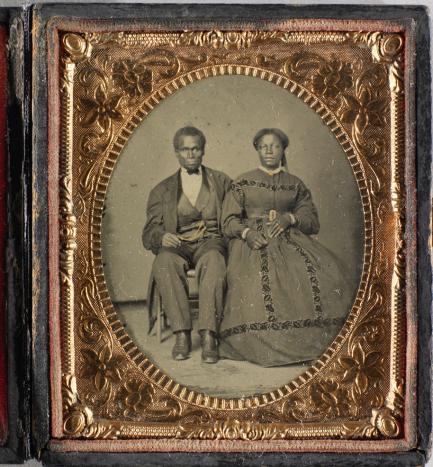“The Kinsey Collection”: Nearly Four Centuries of African American History on View at the Smithsonian
Bernard and Shirley Kinsey have explored and celebrated their African American heritage by collecting items of historical and cultural significance throughout their more than 40-year marriage—from an early version of the Emancipation Proclamation to correspondence between Malcolm X and Alex Haley, and from slave shackles to a 1773 first-edition copy of poems by Phillis Wheatley. The collection spans nearly four centuries and documents the hardships and the triumphs of the African American experience. “The Kinsey Collection: Shared Treasures of Bernard and Shirley Kinsey—Where Art and History Intersect” will be on view Oct. 15 through May 1, 2011, in the National Museum of African American History and Culture Gallery in the National Museum of American History at 14th Street and Constitution Avenue N.W. in Washington.
More than 100 items from the collection are brought together for a new exhibition organized by the Bernard and Shirley Kinsey Foundation for the Arts and Education in collaboration with the Smithsonian’s National Museum of African American History and Culture. Among the items are bills of sale, advertisements, letters and legal papers documenting the slave trade, hand-colored tintypes from the Civil War era and items spotlighting key moments in the civil rights movement, including the Woolworth store boycotts and the 1963 March on Washington. A history of the African American in art is charted through works by numerous celebrated artists, including Romare Bearden, Elizabeth Catlett, Aaron Douglas, Sam Gilliam, Palmer Hayden, Richard Hunt, Lois Mailou Jones, Artis Lane, Richard Mayhew, James Porter and Henry O. Tanner.
Gallery visitors will be able to learn more about selected pieces in the exhibition by participating in its cell phone tour. The tour commentary is narrated by actors, including Angela Bassett, Louis Gossett Jr. and Dennis Haysbert.
“The National Museum of African American History and Culture is pleased to exhibit ‘The Kinsey Collection,’ one of the finest holdings of African American history and culture in the country,” said Lonnie G. Bunch III, the museum’s founding director. “Often museums undervalue the work of private collectors like the Kinseys. With this exhibition we honor their vision and their commitment to preserving an essential element of American culture.”
Bernard and Shirley Kinsey, Floridians by birth and graduates of Florida A&M University, began collecting as a way to remember their travels, but their collection soon became a repository for African American intellectual, historical and artistic works. The Kinseys feel their collection helps give a well-rounded look at the African American experience and the roles African Americans played in building this country, providing new perspectives on the nation’s history.
“Our collection brings to light the extraordinary triumphs and accomplishments of our ancestors, and in doing so gives these individuals a voice, a personality and a name,” said Bernard Kinsey.
The exhibition is presented in six sections; among the highlights are:
Stories of Slavery and Freedom spotlights objects, letters and documents offering an unflinching look at slavery from the perspective of Africans who survived it, Union soldiers who fought it and slave owners who perpetuated it. Among the documents is one in ink on paper showing that “Henry Butler buys the freedom of his wife and four children for $100 in 1839.” Among the publications is Harriet Ann Jacobs’ autobiography, Incidents in the Life of a Slave Girl, which she wrote and published in 1861 after spending seven years hiding from her owner in an attic crawl space.
Freedom Struggles—Military Stories and Political Stories explores two viewpoints of the African American community’s efforts to advance through military and political action. Highlights include a 9th Cavalry Buffalo Soldiers Parade Flag, circa 1889, and a letter to President Theodore Roosevelt written in 1903 by a long-lost Kinsey relative decrying the South’s illegal practice of selling individuals convicted of petty crimes—often innocent young black men—to commercial mills and farms.
Freedom to Celebrate Place, Identity and Familyexplores the African American attachment to the land, family history and the natural world. Among the featured art are works by Edward Mitchell Bannister (1828-1904), Beauford Delaney (1901-1979), Aaron Douglas (1899-1979), Robert Scott Duncanson (1817-1872) and Alma Thomas (1891-1978).
Remembering the Faces of a People offers a kaleidoscope of faces and personalities. Among the featured works are a bronze sculpture of a female figure by Elizabeth Catlett (b. 1915), a self-portrait of artist and art historian James A. Porter (1905-1970) and a scene of coastal South Carolina field workers by Jonathan Green (b. 1955).
The Kinsey Collection has been seen at major museums across the country, including the California African American Museum in Los Angeles, the DuSable Museum of African American History in Chicago and the National Underground Railroad Freedom Center in Cincinnati.
A richly illustrated book (Doubleday) with a foreword by Douglas A. Blackmon, Pulitzer Prize-winning author of Slavery by Another Name: The Re-Enslavement of Black Americans from the Civil War to World War II accompanies the exhibition.
The National Museum of African American History and Culture was established in 2003 by an Act of Congress, making it the 19th Smithsonian Institution museum. It is the only national museum devoted exclusively to the documentation of African American life, art, history and culture. The Smithsonian Board of Regents, the governing body of the Institution, voted in January 2006 to build the museum on a five-acre site adjacent to the Washington Monument on the National Mall. The building is scheduled to open in 2015. Until then, NMAAHC is presenting its touring exhibitions in major cities across the country and in its own gallery at the National Museum of American History.
The NMAAHC Gallery at the National Museum of American History is located at 14th Street and Constitution Avenue N.W. in Washington, D.C. It is open daily from 10 a.m. to 5:30 p.m., except Dec. 25. Admission is free. For more information, visit nmaahc.si.edu or call (202) 633-4751 or (202) 633-5285 (TTY). To find the museum on Facebook, visit http://www.facebook.com/NMAAHC.
# # #
SI-453-2010
Fleur Paysour
202-633-4761








